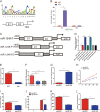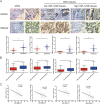P53-induced miR-1249 inhibits tumor growth, metastasis, and angiogenesis by targeting VEGFA and HMGA2
- PMID: 30755600
- PMCID: PMC6372610
- DOI: 10.1038/s41419-018-1188-3
P53-induced miR-1249 inhibits tumor growth, metastasis, and angiogenesis by targeting VEGFA and HMGA2
Abstract
MicroRNAs (miRNAs) are important class of functional regulators involved in human cancers development, including colorectal cancer (CRC). Exploring aberrantly expressed miRNAs may provide us with new insights into the initiation and development of CRC by functioning as oncogenes or tumor suppressors. The aim of our study is to discover the expression pattern of miR-1249 in CRC and investigate its clinical significance as well as biological role in CRC progression. In our study, we found that miR-1249 was markedly downregulated in CRC tissues and cell lines, and negatively related to pN stage, pM stage, TNM stage, and overall survival (OS). Moreover, we demonstrated that miR-1249 was a direct transcriptional target of P53 and revealed that P53-induced miR-1249 inhibited tumor growth, metastasis and angiogenesis in vitro and vivo. Additionally, we verified that miR-1249 suppressed CRC proliferation and angiogenesis by targeting VEGFA as well as inhibited CRC metastasis by targeting both VEGFA and HMGA2. Further studying showed that miR-1249 suppressed CRC cell proliferation, migration, invasion, and angiogenesis via VEGFA-mediated Akt/mTOR pathway as well as inhibited EMT process of CRC cells by targeting both VEGFA and HMGA2. Our study indicated that P53-induced miR-1249 may suppress CRC growth, metastasis and angiogenesis by targeting VEGFA and HMGA2, as well as regulate Akt/mTOR pathway and EMT process in the initiation and development of CRC. miR-1249 might be a novel the therapeutic candidate target in CRC treatment.
Conflict of interest statement
The authors declare that they have no conflict of interest.
Figures








Similar articles
-
MicroRNA-543 suppresses colorectal cancer growth and metastasis by targeting KRAS, MTA1 and HMGA2.Oncotarget. 2016 Apr 19;7(16):21825-39. doi: 10.18632/oncotarget.7989. Oncotarget. 2016. PMID: 26968810 Free PMC article.
-
SP1-induced lncRNA-ZFAS1 contributes to colorectal cancer progression via the miR-150-5p/VEGFA axis.Cell Death Dis. 2018 Sep 24;9(10):982. doi: 10.1038/s41419-018-0962-6. Cell Death Dis. 2018. PMID: 30250022 Free PMC article.
-
miR-622 inhibits angiogenesis by suppressing the CXCR4-VEGFA axis in colorectal cancer.Gene. 2019 May 30;699:37-42. doi: 10.1016/j.gene.2019.03.004. Epub 2019 Mar 6. Gene. 2019. PMID: 30851425
-
Molecular functions of microRNAs in colorectal cancer: recent roles in proliferation, angiogenesis, apoptosis, and chemoresistance.Naunyn Schmiedebergs Arch Pharmacol. 2024 Aug;397(8):5617-5630. doi: 10.1007/s00210-024-03076-w. Epub 2024 Apr 15. Naunyn Schmiedebergs Arch Pharmacol. 2024. PMID: 38619588 Review.
-
MCPIP1 promotes cell proliferation, migration and angiogenesis of glioma via VEGFA-mediated ERK pathway.Exp Cell Res. 2022 Sep 1;418(1):113267. doi: 10.1016/j.yexcr.2022.113267. Epub 2022 Jun 22. Exp Cell Res. 2022. PMID: 35752346 Review.
Cited by
-
MicroRNA-1249 Targets G Protein Subunit Alpha 11 and Facilitates Gastric Cancer Cell Proliferation, Motility and Represses Cell Apoptosis.Onco Targets Ther. 2021 Feb 24;14:1249-1259. doi: 10.2147/OTT.S272599. eCollection 2021. Onco Targets Ther. 2021. PMID: 33658793 Free PMC article.
-
MicroRNAs and angiogenesis: a new era for the management of colorectal cancer.Cancer Cell Int. 2021 Apr 17;21(1):221. doi: 10.1186/s12935-021-01920-0. Cancer Cell Int. 2021. PMID: 33865381 Free PMC article. Review.
-
miR-1249-3p accelerates the malignancy phenotype of hepatocellular carcinoma by directly targeting HNRNPK.Mol Genet Genomic Med. 2019 Oct;7(10):e00867. doi: 10.1002/mgg3.867. Epub 2019 Aug 20. Mol Genet Genomic Med. 2019. PMID: 31429522 Free PMC article.
-
Epigenetic Alterations Upstream and Downstream of p53 Signaling in Colorectal Carcinoma.Cancers (Basel). 2021 Aug 13;13(16):4072. doi: 10.3390/cancers13164072. Cancers (Basel). 2021. PMID: 34439227 Free PMC article. Review.
-
LncRNA MIR205HG regulates melanomagenesis via the miR-299-3p/VEGFA axis.Aging (Albany NY). 2021 Feb 1;13(4):5297-5311. doi: 10.18632/aging.202450. Epub 2021 Feb 1. Aging (Albany NY). 2021. PMID: 33535182 Free PMC article.
References
Publication types
MeSH terms
Substances
LinkOut - more resources
Full Text Sources
Medical
Research Materials
Miscellaneous

